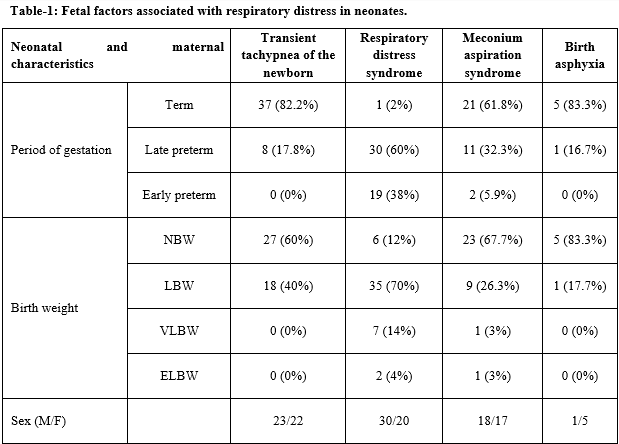An etiological study of respiratory distress in neonates in a tertiary care medical college hospital
Abstract
Introduction: Respiratory distress is the most common cause of NICU admissions in newborns. Early diagnosis of cause of respiratory distress is important in the management of neonatal distress for better outcome. The high incidence of maternal risk factors and newborn receiving poor antenatal care continues to test the abilities of the neonatologist. Inspite of re¬cent advance in clinching diagnosis and management there are very less clinical studies on the neonatal respiratory distress in our country. Therefore, there is a need to know the etiological factors of the babies with respiratory distress.
Materials and methods: A descriptive study of 150 neonates admitted to NICU of Sri Siddhartha Medical College and Hospital with clinical features suggestive of respiratory distress. All the newborn babies who developed respiratory distress within 72 hours of life were included in the study and those who developed respiratory distress after 72 hours of life was excluded from the study.
Results: The commonest cause of neonatal respiratory distress in the present study was Respiratory distress syndrome (34%), followed by Transient tachypnoea of the newborn (30%), and Meconium aspiration syndrome (22.66%). LSCS was most common mode of delivery.
Conclusion: The most common causes of respiratory distress were RDS, TTNB, MAS, and birth asphyxia. Proper antenatal care and early diagnosis of the antenatal complication and avoiding preterm deliveries will aid in the better outcome of the newborns. Early detection and appropriate management are essential to ensure better outcome in all infants presenting with respiratory distress.
Downloads
References
Bajad M, Goyal S, Jain B. Clinical profile of neonates with respiratory distress. Int J Contemp Pediatr. 2016;3(3):1009-1003. doi: http://dx.doi.org/10.18203/2349-3291.ijcp20162382.
Brahmaiah P, Reddy KR. Etiological Study of respiratory distress in newborn. Int J Contemp Med Res. 2017;4(10):2202-2206.
Chandrasekhar R, Mohan MM, Lakshmi BV. Clinical study of respiratory distress in newborn. Int J Contemp Pediatr.2016;10:2349-3291. doi: http://dx.doi.org/10.18203/2349-3291.ijcp20162364.
Guha D. NNF Recommended basic perinatal-neonatal nomenclature. Neonatology-Principles and Practice. 1998;1:131-132.
John BM, Venkateshwar V, Dagar V. Predictors of Outcome in Neonates with Respiratory Distress. J Nepal Paediatr Soc 2015;35(1):31-37. doi: https://doi.org/10.3126/jnps.v35i1.11868.
Rao GC, Rao MS. Etiological profile of respiratory distress in first day of life of a newborn baby. Int J Contemp Pediatr. 2017;4(1):210-214. doi: http://dx.doi.org/10.18203/2349-3291.ijcp20164606.
Amarendra M, Rama G, Kiran CR, Raju DV. Aetiology of respiratory distress and risk factors associated with development of respiratory distress in term newborns. Hernia. 2017;1(1):100. doi: https://doi.org/10.18410/jebmh/2017/163.
Misra PK. Respiratory distress in newborn. A prospective study. Indian pediatrics. 1987;24(1):77-80.
Swarnkar K, Swarnkar M. Neonatal respiratory distress in early neonatal period and its outcome. Int J Biomed Adv Res. 2015;6(09):643-647. doi: https://doi.org/10.7439/ijbar.
Kommawar A, Borkar R, Vagha J, Lakhkar B, Meshram R, Taksandae A. Study of respiratory distress in newborn. Int J Contemp Pediatr. 2017;4(2):490-494. doi: http://dx.doi.org/10.18203/2349-3291.ijcp20170695.
Tudehope DI, Smyth MH. Is transient tachypnoea of the newborn” always a benign disease? Report of 6 babies requiring mechanical ventilation. Aust Paediatr J. 1979;15(3):160-165. doi: https://doi.org/10.1111/j.1440-1754.1979.tb01215.x.
Dani C, Reali MF, Bertini G, Wiechmann L, Spagnolo A, Tangucci M, et al. Risk factors for the development of respiratory distress syndrome and transient tachypnoea in newborn infants. Italian Group of Neonatal Pneumology. Europe Resp J. 1999;14(1):155-159.
Malhotra AK, Nagpal R, Gupta RK, Chhajta DS, Arora RK. Respiratory distress in newborn: treated with ventilation in a level II nursery. Indian Pediatr. 1995;32:207-207.
Luerti M, Parazzini F, Agarossi A, Bianchi C, Rocchetti M, Bevilacqua G. Risk factors for respiratory distress syndrome in the newborn: a multicenter Italian survey. Acta Obstetricia et Gynecologica Scand. 1993;72(5):359-364. doi: https://doi.org/10.3109/00016349309021113.
Lee KS, Eidelman AI, Tseng PI, Kandail SR, Gartner LM. Respiratory distress syndrome of the newborn and complications of pregnancy. Pediatr. 1976;58(5):675-80.
Jain L, Dudell GG. Respiratory transition in infants delivered by cesarean section. Seminars in Perinatol. 2006;30(5):296-304. doi: 10.1053/j.semperi.2006.07.011.
Santosh S, Kushal KK, Adarsha E. A clinical study of respiratory distress in newborn and its outcome. Indian J Neonatal Med Res. 2013;1(1):2-4.

Copyright (c) 2020 Author (s). Published by Siddharth Health Research and Social Welfare Society

This work is licensed under a Creative Commons Attribution 4.0 International License.


 OAI - Open Archives Initiative
OAI - Open Archives Initiative


